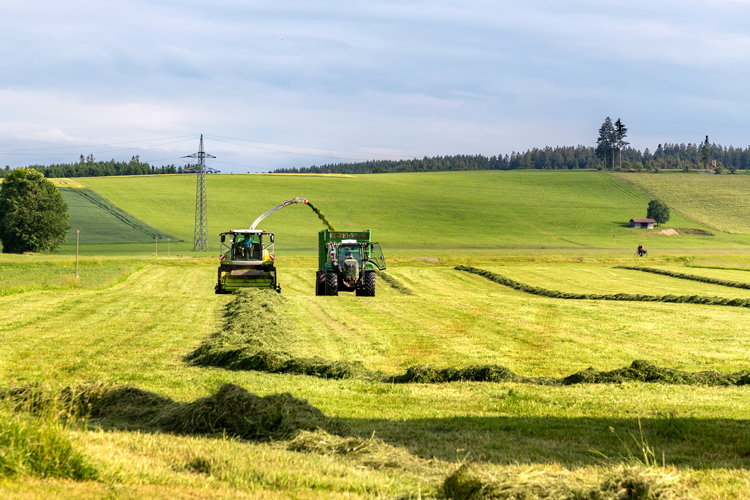The author is a dairy nutrition and management consultant in Michigan for GPS Dairy Consulting.

This past winter has been notably colder compared to recent years, but as we approach May, warmer weather and the time for haylage harvest will soon be upon us.
Each spring, I hold preharvest meetings with my dairy clients to review and assess the previous year’s haylage harvest and forage quality. During these meetings, we identify areas of success and strategies for improvement. Additionally, we will go through the GPS FeedFIT nine-step process for harvesting high-quality haylage. While I will not discuss all nine steps here, I would like to highlight my top four priorities, which are:
- Harvest timing
- Dry matter (DM)
- Relative forage quality (RFQ)
- Filling and packing
Harvest timing
When to cut is a frequent query that tends to arise around the first week of May. There are several approaches to addressing this. In some cases, I have taken scissors cuttings across a field and sent them into the forage testing laboratory for analysis to understand where the plant stands in terms of quality. Relative forage quality (RFQ) is used as an index. In other instances, I have considered growing degree day accumulations. What I have found to be the most helpful in making a cutting decision is an evaluation of the height and health of the plant.
I typically target a 24- to 26-inch height for first cutting and 21 to 23 inches for the subsequent cuttings. Conventional alfalfa varieties are targeted for the lower end of the height range and reduced-lignin varieties for the higher end. Metrics may be slightly different among farms or geographies, so I suggest using this approach in combination with past years’ history. Saving pictures with plant height and comparing them to feed-out quality over the years has helped me guide clients. Additionally, considering weather events and plant health is included in this decision-making process.
Dry matter
Maintaining appropriate dry matter content in haylage is essential to ensure a good fermentation. The cutoff point I follow is 38% DM, as wetter haylage such as 35% DM can pose risks and potentially result in pickled or butyric haylage, which adversely affects cow performance. Ideally, 40% DM is where I like to see most haylage harvested. Exceeding 45% DM can present challenges and boosts the likelihood of plugged choppers or mold development during storage.
Relative forage quality
For high-quality cow haylage, I target 175 to 185 RFQ at feedout. This may mean cutting a standing crop at 15 to 20 points higher than these values to accommodate for harvest and fermentation losses. As stated earlier, a system needs to be put in place to track results from past years, as the target RFQ will likely be different from farm to farm.
If possible, I target lower quality haylage (130 to 140 RFQ) for heifers and dry cows. This all depends on a farm’s ability to be able to store this haylage in a separate pile.
Filling and packing
Our goals for filling and packing a bunker or pile are to fill quickly, safely, and efficiently, and then to cover the haylage rapidly to eliminate oxygen to ensure a good fermentation.
Construct a pile so that it has a consistent density, aiming for 18 pounds or more of dry matter per cubic foot. Match the packing tractor capacity and the number of tractors with the tonnage of haylage being delivered. A guideline to follow is: tractor(s) weight divided by 800 equals the number of wet tons per hour that can be adequately packed.
During filling, spread the crop in 6- to 8-inch layers. I have found that large windrows of haylage across the bunk indicate that haylage is coming in too fast, and there is insufficient equipment to manage the material being delivered. It is also necessary to maintain bunks with a proper slope of 18% or lower. Ensuring that all haylage is tightly packed on all sides is crucial for proper fermentation and preventing spoilage.
Have safety in mind
In addition to the technical aspects of putting up an excellent alfalfa haylage crop, don’t forget to prioritize the human aspects and safety measures. Ensure high-visibility vests are worn in high-traffic areas such as feed pads. Make eye contact with equipment operators to confirm they are aware of your presence before entering their workspace, and identify a safe zone where you can relocate during busy periods.
Harvesting quality haylage requires a system. It is essential to establish a procedure for determining the appropriate time to cut, set dry matter and quality targets, and understand processes for filling and packing. Conduct all of these steps while prioritizing safety. •
This article appeared in the April/May 2025 issue of Hay & Forage Grower on page 25.
Not a subscriber?Click to get the print magazine.

